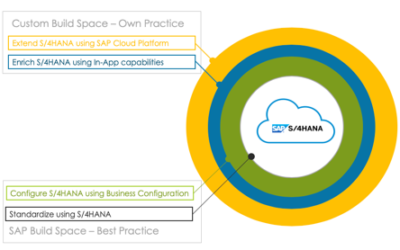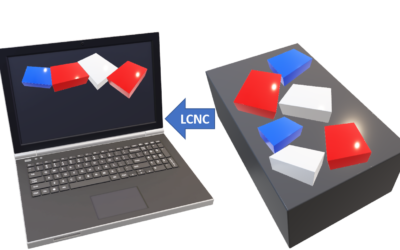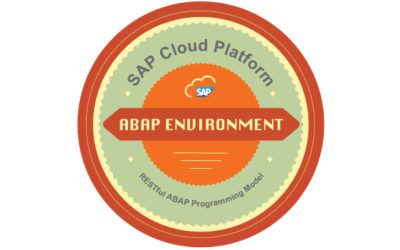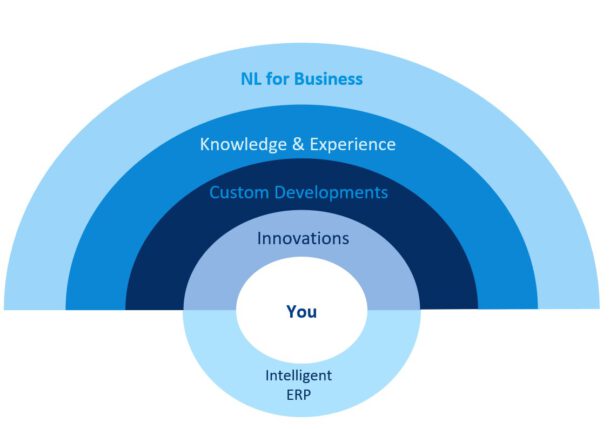
Software vendors want organizations to move their developments to cloud platforms. The vendors promised that once organizations migrate to the cloud, they should become more agile, can adopt innovations faster, and can control project costs by starting small and scale up quickly.
Organizations can support their processes with best-in-class cloud applications from different vendors and will have more options to implement their own-practice during their digital transformation journey. The developers can use the best-fitting program language. And End-users can use the device which fits the best to fulfill their work.
To achieve all these promises, software vendors had to restructure their software. As also mentioned in my blog Freedom of User Interfaces, software vendors should ideally separate their UI logic and business logic and provides this logic as cloud business APIs. In this blog, I focus on the value of cloud business APIs for software vendors and its customers and why these APIs play an essential role in the digital transformation.
Why do software vendors shift to the cloud?
For newly designed applications, the separation of UI and business logic isn’t hard to implement. But for existing software, this isn’t that easy. Splitting the UI from the business logic and provide this logic as APIs is a lot of work and expensive too. And after the separation, the supporting software is still working the same as before. So, you can ask yourself the question:
‘What is the reason that traditional software vendors shift to the cloud and why do they invest in splitting the UI logic and business logic.’
Of course, software vendors can run their applications as a hosted service on a cloud platform. But this will not bring any significant value. It will bring even the opposite. Besides the responsibility of the code line, they now also become responsible for the execution and support. However, if they don’t shift to the cloud, they can become obsolete and will be replaced by the new cloud vendors.
So for traditional software vendors, the only way to survive is by going to the cloud. And in a worse case, they need to compete against pure cloud vendors that design their solutions from the ground with a cloud mindset. A competition that traditional software vendors only will win with a web-based UI and business logic accessible through a rich feature set of business APIs. So splitting the UI and business logic is crucial for surviving. This splitting is expensive and time-consuming but will also bring significant additional value: it opens their applications for innovations and flexibility.
Value of cloud business APIs
Vendors can test business logic, provided as multiple black-box business APIs, separately to improve the quality of their software. They can call the API from any code line in any language that will speed up developments. They can reuse their own logic or use APIs of their partners. And the vendor can improve the code behind the API without impact for the user. The loosely coupled UI from the business logic gives software vendors the possibility to adapt to new UI technologies faster.
The cloud route of traditional software vendors is also good news for the organizations which use their applications. Next to the vendor UIs, organizations can build multiple role-based and straightforward best-fitting UIs on top of the business APIs. This way, the operational costs can be lower due to lower training costs, reduced errors, and speed up processes.
This low hanging fruit gives organizations already the possibility to get value by shifting to cloud applications.
Digital revolution strategies
But more valuable is the possibility to innovate the pre-execution phase. The phase where data will be collected, validated and approved. And it comes before the execution phase, where the business API will be called and stores the data in the backend application.
Within organizations, the execution phase is mostly already standardized based on best-practices business applications. But the pre-execution stage is unique within organizations and differentiates the same type of companies. It creates the differentiation of the organization in the market. The way of working is primarily implemented as own-practice processes supported by manual and unstructured work or supported by own developed software. And most of the time, historical and organizational arguments are the reasons why they still work the way they do.
I believe the digital revolution strategies of companies should mainly focus on these pre-execution processes. Quick innovations are possible by replacing or reducing manual effort by automation. But, organizations have to develop solutions by themselves because of the different ways organizations are running their procedures.
Hyperscaler cloud platform vendors
Hyperscaler cloud platform vendors like Amazon AWS, Google Cloud, Alibaba Cloud, and Microsoft Azure and business software vendors like SAP, identify these needs. These cloud vendors provide flexible platforms with additional business services supported by big data, machine learning, and artificial intelligence. These business services are available as APIs. And help companies to solve business requirements by simplifying and digitalize the pre-execution phase. Custom-build applications use business services to enrich the initial data based on related process data. They do proposals based on historical and predicted data. And make automated decisions and approvals based on fixed rules or learned patterns. In some cases, the custom-build code takes over the complete pre-execution phase as a background job without human interaction. In this case, the application only needs human actions when an exception occurs.
Opportunities and threats
The shift to cloud applications and business services also creates a new dimension for supporting business processes with IT. Companies will choose best-of-breed API-enabled business applications to standardize their work processes and achieve operational excellence. But also want a flexible and agile cloud platform to build fast, innovative custom-build applications based on open standards and without boundaries. This change is a big challenge for IT development, running implementation projects.
In traditional business software developments, the developer built an isolated application for one runtime. The program also uses stable libraries and databases which are deployed together. It gives companies full control over the application and the running hardware.
But for cloud applications, this is not the case anymore. The business logic, data storage, and device capabilities are hidden behind black-box APIs and can run anywhere.
This shift is good news. In-house developers are not restricted to propriety libraries anymore but can use any API written in any language and running on any runtimes. Organizations don’t have to invest in and wait for hardware but can start within minutes. They can grow with their needs, and only have to pay for the resources they use. And they don’t have to maintain and support the business logic behind the APIs,
On the other side, for in-house developed applications, the playground also will change. These custom-build applications will strongly depend on these cloud business APIs. Developers should evaluate not only the functionality and added value, but also their usage costs, availability and stability, security, regulation, and data protection. And traditional developers and development organizations are usually not familiar with these topics.
Challenges for custom-build applications
For development departments, this will be a significant change. Instead of multiple isolated development streets, they need to integrate them. Companies need guidelines and decision flows that help them to determine which business logic they want to build on their own and made them available for others. This change also the way developers should work. They first have to check if business logic, including required needs, is already available as API within the company. If this is the case, they should know the consequences of the usage of this API. If this is not the case, they need guidelines on how to proceed.
In traditional software development, libraries can be easily embedded in their program and are often for free. But the use of API’s on a cloud platform comes with cost and dependency. You should be sure that the API will be highly available for the lifetime of your applications, and if this cannot be guaranteed, you need to have a failback approach.
Conclusion
The dynamic of cloud applications and business APIs will be a big challenge for IT organizations and their developers. It will bring operational excellence and faster innovations but also higher risk and more complexity. Still, organizations will shift to cloud applications because it is one of the most valuable key drivers to be successful in their digital transformation.
Next steps
Our advisors, design thinking coaches, architects, consultants, and trainers of NL for Business are ready to help you to innovate your SAP practice. Since 2001, we primarily focus on custom build innovations on top of SAP solutions and use our EasyRun approach to bring success to your organization. If you have any questions or want more information, please contact us.




